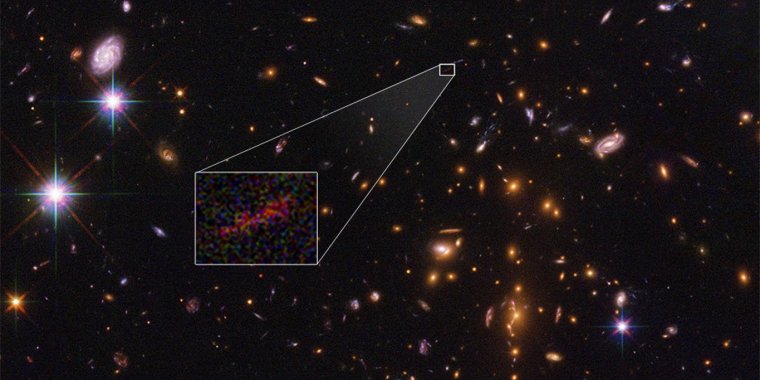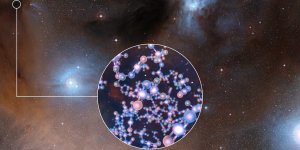| News / Space News |
NASA's Great Observatories Team Up to Find Magnified and Stretched Image of Distant Galaxy
An intensive survey deep into the universe by NASA's Hubble and Spitzer space telescopes has yielded the proverbial needle-in-a-haystack: the farthest galaxy yet seen in an image that has been stretched and amplified by a phenomenon called gravitational lensing.

This Hubble Space Telescope image shows the farthest galaxy yet seen in an image that has been stretched and amplified by a phenomenon called gravitational lensing. Image credit: NASA/ESA/STScI/B. Salmon
The embryonic galaxy named SPT0615-JD existed when the universe was just 500 million years old. Though a few other primitive galaxies have been seen at this early epoch, they have essentially all looked like red dots, given their small size and tremendous distances.
However, in this case, the gravitational field of a massive foreground galaxy cluster not only amplified the light from the background galaxy but also smeared the image of it into an arc (about 2 arcseconds long).
No other candidate galaxy has been found at such a great distance that also gives you the spatial information that this arc image does. By analyzing the effects of gravitational lensing on the image of this galaxy, we can determine its actual size and shape.
First predicted by Albert Einstein a century ago, the warping of space by the gravity of a massive foreground object can brighten and distort the images of far more distant background objects. Astronomers use this "zoom lens" effect to go hunting for amplified images of distant galaxies that otherwise would not be visible with today's telescopes.
SPT0615-JD was identified in Hubble's Reionization Lensing Cluster Survey (RELICS) and companion S-RELICS Spitzer program.
By combining the Hubble and Spitzer data, the team calculated the lookback time to the galaxy of 13.3 billion years. Preliminary analysis suggests the diminutive galaxy weighs in at no more than 3 billion solar masses (roughly 1/100th the mass of our fully grown Milky Way galaxy).
It is less than 2,500 light-years across, half the size of the Small Magellanic Cloud, a satellite galaxy of our Milky Way. The object is considered prototypical of young galaxies that emerged during the epoch shortly after the big bang. (NASA)
YOU MAY ALSO LIKE

